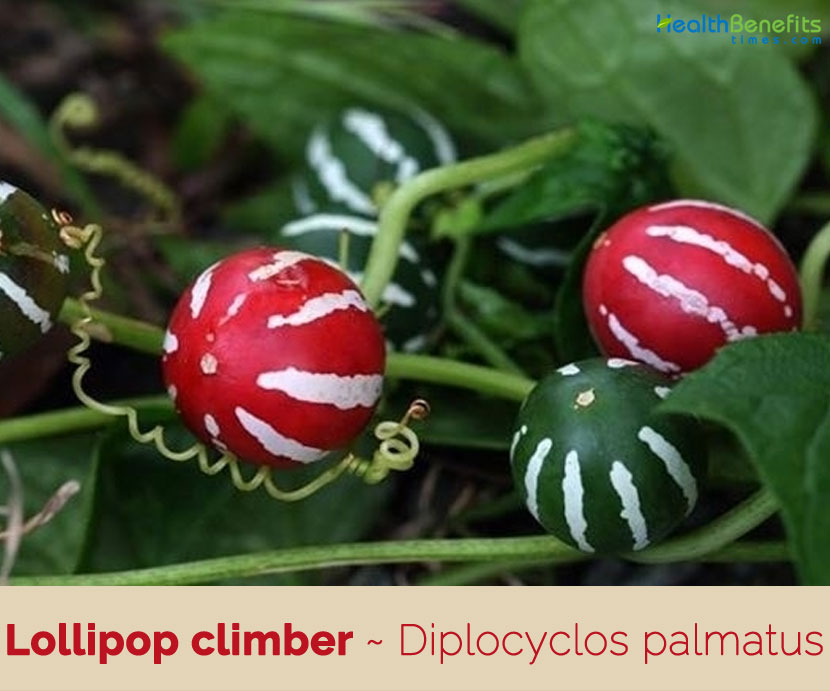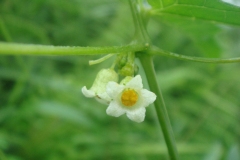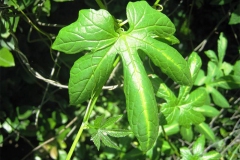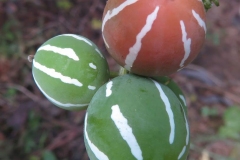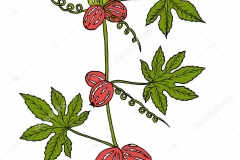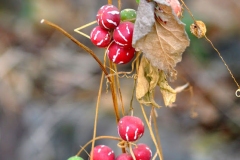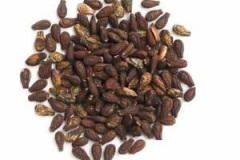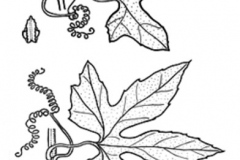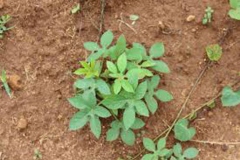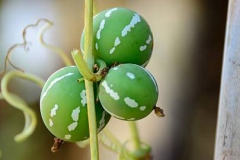| Lollipop climber Quick Facts |
| Name: |
Lollipop climber |
| Scientific Name: |
Diplocyclos palmatus |
| Origin |
Malesia phytoregion, including Papua New Guinea, and in Australia, in Western Australia, Northern Territory, Cape York Peninsula |
| Colors |
Initially green with white blotched stripes and later turn a bright red- orange color when ripe |
| Shapes |
Sub globose, indehiscent berry 1.5–2.5 cm in diameter, solitary or clustered, red with silvery white longitudinal stripes |
| Taste |
Acrid, Bitter |
| Health benefits |
Beneficial for ague, colic pain, enlarged spleen, paralysis of tongue, delirium, convulsions, leucorrhoea, asthma, bronchitis, carbuncles, cholera, colic, cough, fertility, headache, megalosplenyb, phthisis and snake bite |
Diplocyclos palmatus also known as cucumber, striped cucumber or native bryony is a vine in the family Cucurbitaceae. It is commonly known as cucumber, native bryony, striped cucumber, lollipop climber, marble vine and red-striped cucumber. The plant is native to rainforests and dry rainforests habitats in the Malesia phyto region, including Papua New Guinea, and in Australia, in Western Australia, Northern Territory, Cape York Peninsula, North East Queensland, southwards to north-eastern New South Wales. The Latin name Diplocyclos is derived from the Greek word Diplos which means double and kyklos which means ring, and signifies the tendrils coiling. All parts of the plant are toxic in large quantities. The fruits have been supposed of causing illness and death in children. The likeness of the fruits to lollipops makes them very attractive to small children.
Plant Description
Lollipop climber is a short-lived, herbaceous, perennial climbing plant that grows about 6 m tall. The plant is found growing in rain, swamp or other ground-water forests, flood-plains, valley and seasonal swamp grasslands, old cultivations, thickets, monsoon forests, lowland and upland disturbed areas, and mountain rain forest. Annual, much-branched stems are up to 6 meters long from a fleshy rootstock. The stems scramble over the ground, climbing into the surrounding vegetation where it attaches itself by means of tendrils.
Leaves
Leaf-blade is broadly ovate-cordate in outline, glabrous except for a few forward-pointing aculei on the nerves beneath, gland-dotted just above the base, about 6-13 cm long and 6-12 cm broad, palmately 3–7-lobed. Lobes are linear-lanceolate to long-elliptic, usually distinctly narrowed below, entire or especially in the upper parts sinuate or sub serrate with apiculate teeth, acuminate, obtuse to acute and apiculate. Petiole is about 2-4 cm long and is armed with a few forward-curving fairly stout aculeate hairs. Leaves emit an unpleasant odor when crushed. Upper surface of the leaf blade clothed in scattered scabrid hairs. Tendrils are 2- branched, leaf-opposed. Leaves are hairy and bright green on the upper surface and pale and smooth underneath.
Flowers
Usually one female flower and three male flowers are present in each leaf axil. Male flowers are about 20 mm in diameter. Hypanthium is 3-4 mm long, calyx lobes are about 2 mm long, bases inflated, and lobes spreading. Petals are 9-10 mm long, densely hairy on the inner surface. Anthers are 3-4 mm long, filaments about 2 mm long, very hairy towards the base. Two anthers are bilocular, one anther unilocular. Anther locules bent and twisted. Female flowers are about 15 mm in diameter. Calyx lobes are about 2 mm long, bases inflated, and lobes spreading. Petals are about 8 mm long, densely hairy on the inner surface. Staminodes 3, about 3 mm long, densely hairy. Style is about 3 mm long and then branching into 3 arms or stigmas. Flowering normally takes place from August and September.
Fruits
Fertile flowers are followed by ovoid to ellipsoid berry with a diameter of 2-3 cm found solitary or in clusters of 2–5 on 1–5 mm. long stalks. Berries are initially green with white blotched stripes and later turn a bright red- orange color when ripe. Ripe fruits bear 6-10 brown, obovate seeds per fruit. They are irregularly shaped, vaguely like tear drops or bird skulls. The compressed seeds have a length of 4 mm and width of 3 mm and they are usually encircled by a prominent raised band. The plant generally fruits in September and October.
Traditional uses and benefits of Lollipop climber
- The roots are used as anti-venom.
- The fruits and leaves are used to cure stomach-ache.
- The stems are used as an expectorant.
- The fruits are used as a laxative.
- The seeds are febrifuge.
- Leaves as external application for inflammation.
- Various parts of plant used in headache, ague, colic pain, enlarged spleen, paralysis of tongue, delirium and convulsions.
- Fruits have important use in the area of reproductive medicine (female infertility, aphrodisiac, tonic, leucorrhoea etc.)
- Seeds are being used for promoting conception in women.
- Plant is used against snake-bite.
- Its leaves are used in inflammation.
- Roots are used for treatment of asthma.
- Seeds are used for increasing sperm count also as an aphrodisiac.
- Traditional healers use the leaves and the seeds of this plant for treatment of fevers.
- It is also taken in impotency and used as a tonic.
- Whole plant is used to treat adenopathy, ague, asthma, bronchitis, carbuncles, cholera, colic, consumption, cough, delirium, fertility, headache, megalosplenyb, paralysis, phthisis, snake bite.
- It has been traditionally reported to be used as anthelmintics and also ethno medicinal plants used to cure jaundice in Kammam District of Andhra Pradesh, India.
- Indian women occasionally take the seeds in combination with other plant drugs for helping conception and prevent miscarriage.
- Entire plant is used for getting relief from constipation.
- Roots are used as an antivenin and fruits and leaves to cure stomach-ache in Kenya.
- In Thailand stems are used as an expectorant and fruits as a laxative, and in Nepal seeds as a febrifuge.
Ayurvedic Health benefits of Lollipop climber
- Blocked Fallopian Tubes: Take 1 teaspoon of Lollipop climber seeds powder with warm water on empty stomach every morning for at least 2 to 3 months.
- Infertility: Take dried Putra jeevak Seed powder and Lollipop climber seed powder. Take half teaspoon of each powder 2 times in a day. Repeat the process for 3 months.
- Increasing chances of conception: The seeds of Lollipop climber, taken with milk, promote the conception.
- Improve sperm count: The seed powder is used for increasing sperm count.
- Pregnancy: Take seeds of the plant and make small pills with jaggery. Take 2 pills twice in a day for half month.
- Biliousness: Leaf juice mixed with milk is taken.
- Burn: Plant decoction is applied externally.
- Carbuncles, furuncles: Whole plant paste is applied topically.
- Cough, diabetes, abdominal gas: Leaf juice with honey or sugar is given.
- Fever: Take seeds of the plant and make paste. Eat 2 gm of this paste twice a day for 5 days.
- Inflammation: Leaves are tied on the affected body part.
- Respiratory problems, asthma: Leaves are fried in coconut oil and taken.
- Waist pain: Tender twigs are fried along with onion and eaten.
Culinary uses
- Leaves are cooked and eaten as a vegetable. Some other reports suggest the leaves are poisonous.
- Young fruits and shoots are occasionally eaten in South-East Asia. The fruits are considered poisonous in some countries.
Other Facts
- In some areas the plant is considered toxic, whilst in others it is harvested from the wild for local use as a food and medicine.
- It is sometimes grown as a garden ornamental, being valued especially for its decorative fruits.
Precautions
- Dried leaves have caused deaths in calves and ewes.
- All parts of the plant are extremely poisonous.
- Several children are said to have died after eating the fruit.
References:
https://npgsweb.ars-grin.gov/gringlobal/taxonomydetail.aspx?id=409855
http://keys.trin.org.au/key-server/data/0e0f0504-0103-430d-8004-060d07080d04/media/Html/taxon/Diplocyclos_palmatus.htm
http://tropical.theferns.info/viewtropical.php?id=Diplocyclos+palmatus
https://www.flowersofindia.net/catalog/slides/Lollipop%20Climber.html
https://indiabiodiversity.org/species/show/229562
http://envis.frlht.org/plantdetails/a2fabc83839c69ce0bef32ea7db8a9b3/321f2c9e524b50a39528528a82602645
https://shodhganga.inflibnet.ac.in/bitstream/10603/192205/3/13.chapter3,review%20of%20literature.pdf
http://powo.science.kew.org/taxon/urn:lsid:ipni.org:names:292565-1
https://gd.eppo.int/taxon/DPYPA
https://en.wikipedia.org/wiki/Diplocyclos_palmatus
http://www.ijrpc.com/files/25-336.pdf
https://www.researchgate.net/publication/331821986_DIPLOCYCLOS_PALMATUS_A_PHYTOPHARMACOLOGICAL_REVIEW
https://uses.plantnet-project.org/en/Diplocyclos_palmatus_(PROTA)
Comments
comments


